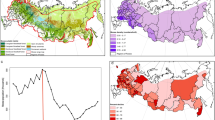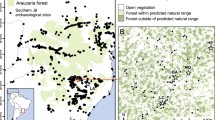Abstract
The present vegetation-climate relationships have been used to deduce past climate based on paleoecological indicators of past vegetation (Grichuk et al. 1984; COHMAP) and to predict future vegegation distribution based on General Circulation Model projections of future climate (Pastor and Post 1988). The implicit assumption behind these climatic reconstructions is that climate is the major factor determining vegetation distribution. However, animals also strongly influence the species composition, structure, and processes of ecosystems (O’Neill 1976), including boreal forest (Pastor et al. 1988; Bryant et al. 1991) and tundra (Batzli et al. 1980). Consequently, changes in animal abundance can radically alter the structure and species composition of vegetation (Bond 1993), for example, converting grassland to shrubland or forest (Owen-Smith 1987; Schlesinger et al. 1990). Predicting the future structure and distribution of ecosystems (Pastor and Post 1988; IGBP 1990) may, therefore, require consideration of animal diversity and trophic interactions as well as direct effects of climate on vegetation.
Access this chapter
Tax calculation will be finalised at checkout
Purchases are for personal use only
Preview
Unable to display preview. Download preview PDF.
Similar content being viewed by others
References
Batzli GO (1977) The influence of grazers on tundra vegetation and soils. Circumpolar Conf on Northern ecology, Proc 1: 215–225
Batzli GO, Sobaski S (1980) Distribution, abundance, and foraging patterns of ground squirrels near Atkasook, Alaska. Arct Alp Res 12: 501–510
Batzli GO, White RG, MacLean SF Jr, Pitelka FA, Collier BD (1980) The herbivore-based trophic system. In: Brown J, Miller PC, Tieszen, LL, Bunnel FL (eds) An arctic ecosystem: the coastal tundra at Barrow, Alaska. Dowden, Hutchinson and Ross, Stroudsburg, pp. 335–410
Bond WJ (1993) Keystone species. In: Schulze E-D, Mooney HA (eds) Ecosystem function and biodiversity. Springer Berlin Heidelberg New York, pp 237–253
Bryant JP, Chapin FS III (1986) Browsing-woody plant interactions during boreal forest plant succession. In; Van Cleve K, Chapin FS III, Flanagan PW, Viereck LA, Dyrness CT (eds) Forest ecosystems in the Alaskan taiga; a synthesis of structure and function. Springer Berlin Heidelberg New York, pp. 213–225
Bryant JP, Kuropat PJ (1980) Selection of winter forage by subarctic browsing vertebrates: the role of plant chemistry Annu Rev Ecol Syst 11: 261–285
Bryant JP, Provenza FP, Pastor, J, Reichardt PB, Clausen TP, du Toit JT (1991) Interactions between woody plants and browsing mammals mediated by secondary metabolites. Annu Rev Ecol Syst 22: 431–446
Chapin FS III (1991) Effects of multiple environmental stresses on nutrient availability and use. In: Mooney HA, Winner WE, Pell EJ (eds) Response of plants to multiple stresses. Academic Press, San Diego, pp. 67–88
Chapin FS III(1993) Functional role of growth forms in ecosystem and global processes. In: Ehleringer JR, Field CB (eds) Scaling physiological processes: leaf to globe. Academic Press, San Diego, pp. 287–312
Chapin FS III, Shaver GR (1981) Changes in soil properties and vegetation following disturbance in Alaskan arctic tundra. J Appl Ecol 18: 605–617
Chapin FS III, Shaver GR (1985) Individuahstic growth response of tundra plant species to environmental manipulations in the field. Ecology 66: 564–576
Chapin FS III, McKendrick JD, Johnson DA (1986) Seasonal changes in carbon fractions in Alaskan tundra plants of differing growth form: implications for herbivores. J Ecol 74:707–731
Chapin FS III, Shaver GR, Gibbin AE, Nadelhoffer KG, Laundre JA (1994) Response of arctic tundra to experimental and observed changes in climate., Ecology (in press)
Chernov YI (1978) Struktura zhivotnogo naseleniia Subarktiki, Nauka, Moscow
Chernov YI (1980) Zhizn’ tundry. Mysl’, Moscow
Chernov YI, Matveeva N V, Zanokha LL (1983) Opyt izucheniia prirosta tsvetkovykh rastenii V coobshchestvakh Taimyra. Dokl Akad Nauk SSSR 272: 999–1002
COHMAP (1988) Climatic changes of the last 18,000 years: observations and model simulations. Science 241: 1043–1052
Collatz GJ, Ball JT, Grivet C, Berry J A (1991) Physiological and environmental regulation of stomatal conductance, photosynthesis and transpiration: a model that includes a laminar boundary layer. Agric For Meteorol 54: 107–136
Coulson JC, Butterfield J (1978) An investigation of the biotic factors determining the rates of plant decomposition on blanket bog. J Ecol 66: 631–650
Farquhar GD, Sharkey TD (1982) Stomatal conductance and photosynthesis. Annu Rev Plant Physiol 33:317–345
Field C, Chapin FS III, Matson PA, Mooney H A (1992) Responses of terrestrial ecosystems to the changing atmosphere:a resource-based approach. Annu Rev Ecol Syst 23: 201–235
Fox JF (1978) Forest fires and the snowshoe hare-Canada lynx cycle. Oecologia 31: 349–374
Grichuk V P (1984) Late Pleistocene vegetation history. In: Velichko A A (eds) Late Quaternary environments of the Soviet Union. University of Minnesota Press, Minneapolis, pp. 155–178
Grichuk VP, Gurtovaya YY, Zelikson EM, Borisova OK (1984) Methods and results of Late Pleistocene paleoclimatic reconstructions. In: Velichko AA (eds) Late Quaternary environments of the Soviet Union. University of Minnesota Press, Minneapolis, pp 251–260
Guthrie RD (1990) Frozen fauna of the mammoth steppe: the story of Blue Babe. University of Chicago Press, Chicago
Haynes G (1982) Utilization and skeletal disturbances of North American prey carcasses. Arctic 35:266–281
Hopkins DM (1967) The Cenozoic history of Beringia-a synthesis. In: Hopkins DM (eds) The Bering land bridge. Stanford University Press, Stanford, pp 451–484
Hopkins DM, Matthews JJV, Schweger CE, Young SB (eds) (1982) Paleoecology of Beringia, Academic Press, New York
IGBP (1990) The international geosphere-biosphere programme: a study of global change. Rep No 12. IGBP Secretariat, Stockholm
Johnson LC, Damman AWH (1991) Species controlled Sphagnum decay on a South Swedish raised bog. Oikos 61:234–242
Kriuchkov VV (1973) Krainii Sever: problemy ratsional’nogo ispol’zovaniia prirodnykh resursov. Mysl’, Moscow
Kucheruk VV (1985) Travoiadnye mlekopitaiushchie v aridnykh ekosisemakh vnetropicheskoi Evrasii. In: Sokolov BE (eds) Mlekopitaiushchie v nazemnykh ekosistemakh. Nauka, Moscow, pp 166–224
Manabe S, Broccoli AJ (1985) The influence of continental ice sheets on the climate of an ice age J Geophys Res 90D:2167–2190
Martin PS (1984) Prehistoric overkill: the global model. In: Martin PS, Klein RG (eds) Quaternary extinctions. University of Arizona Press, Tucson, pp 354–403
McKendrick JD, Ott VJ, Mitchell GA (1978) Eff’ects of nitrogen and phosphorus fertilization on carbohydrate and nutrient levels in Dupontia fisheri and Arctagrostis latifolia. In: Tieszen LL (eds) Vegetation and production ecology of an Alaskan arctic tundra. Springer, Berlin Heidelberg, New York, pp 509–537
McKendrick JD, Batzh GO, Everett KR, Swanson JC (1980) Some effects of mammalianherbivores and fertilization on tundra soils and vegetation. Arct Alp Res 12:565–578
McNaughton SJ (1979) Grazing as an optimization process: grass-ungulate relationships in theb Serengeti.Am Nat 113:691–703
O’Neill RV (1976) Ecosystem persistence and heterotrophic regulation. Ecology 57:1244–1253
Owen-Smith RN (1987) Pleistocene extinctions: the pivotal role of megaherbivores. Paleobiology 13:351–362
Pastor J, Post WM (1988) Responses of northern forests to C02-induced climate change. Nature 334:55–58
Pastor J, Naimen RJ, Dewey B, Mclnnes P (1988) Moose, microbes, and the boreal forest. Bioscience 38:770–777
Peshkova NV, Andreiashchkina NI (1983) Produktivnost’ dvukh podvidov Carex aquatilis i eè izmenenie pod vliianiem mnogokratnogo otchuzhdeniia nadzemnoi biomassy. Ekologiia 4:30–35
Rind D (1987) Components ofthe ice age circulation. J Geophys Res 92D:4241–4281
Schlesinger WH, Reynolds JF, Cunningham GL, Huenneke LF, Jarrell WM, Virginia RA, Whitford WG (1990) Biological feedbacks in global desertification. Science 247:1043–1048
Shaver GR, Chapin FS III (1986) Effect of fertilizer on production and biomass of tussock tundra, Alaska, U.S.A. Arct Alp Res 18:261–268
Sher AV (1988) Sreda obitaniia plio-pleistotsenovykh mlekopitaiushchikh severo-vostochnoi Siberi. Stratigraphiia i korreliatsiia chetvertichnykh otlozhenii Azii i Tikhookeanskogo regiona. Akademii Nauk SSSR, Vladivostok, pp 78–79
Skre O, Oechel WC (1979) Moss production in a black spruce Picea mariana forest with permafrost near Fairbanks, Alaska, as compared with two permafrost-free stands. Holarct Ecol 2:249–254
Skre O, Oechel WC (1981) Moss functioning in different taiga ecosystems in interior Alaska. I. Seasonal, phenotypic, and drought effects on photosynthesis and response patterns. Oecologia 48:50–59
Thing H (1984) Feeding ecology of the West Greenland caribou (Rangifer tarandus groen-landicus) in the Sismiut Kangerlussuaq region. Dan Rev Game Biol 12:1–52
Tishkov AA (1985) Rastitel’noiadnye mlekopitaiushchie v ekosistemakh tundry. In: Sokolov VE (eds) Mlekopitaiushchie v nazemnykh ekosistemakh. Nauka, Moscow, pp 38–67
Tormirdiaro SV (1978) Natural process and development of territories ofthe permafrost zone. Nedra Press, Moscow
Van Cleve K, Dryness CT, Viereck LA, Fox J, Chapin FS III, Oechel WC (1983) Taiga ecosystems in interior Alaska. Bioscience 41:78–88
Van Cleve K, Chapin FS III, Dryness CT, Viereck LA, (1991) Element cychng in taiga forest: state-factor control. Bioscience 41:78–88
West FH (1981) The archaeology of Beringia. Columbia University Press, New York
White RG, Trudell J (1980) Habitat preference and forage consumption by reindeer and caribou near Atkasook, Alaska. Arct Alp Res 12:511–529
Wolff JO (1980) The role of habitat patchiness in the population dynamics of snowshoe hares.Ecol Monogr 50:111–129
Yurtsev BA (1974) Steppe communities in the Chukotka tundra and the Pleistocene “tundra-Steppe”. Bot Zh 59:484–501
Zimov SA (1990) Chelovek i priroda Se vera: garmoniia protivopolozhnostei. Vestn Akad Nauk SSSR 2:118–133
Zimov SA, Chuprynin VI (1991) Ekosistemy: ustoichivost’, konkurentsia tslenapravlennoye preobrazovanie. Nauka,Moscow
Author information
Authors and Affiliations
Editor information
Editors and Affiliations
Rights and permissions
Copyright information
© 1995 Springer-Verlag Berlin Heidelberg
About this chapter
Cite this chapter
Zimov, S.A., Chuprynin, V.I., Oreshko, A.P., Chapin, F.S., Chapin, M.C., Reynolds, J.F. (1995). Effects of Mammals on Ecosystem Change at the Pleistocene-Holocene Boundary. In: Chapin, F.S., Körner, C. (eds) Arctic and Alpine Biodiversity: Patterns, Causes and Ecosystem Consequences. Ecological Studies, vol 113. Springer, Berlin, Heidelberg. https://doi.org/10.1007/978-3-642-78966-3_9
Download citation
DOI: https://doi.org/10.1007/978-3-642-78966-3_9
Publisher Name: Springer, Berlin, Heidelberg
Print ISBN: 978-3-642-78968-7
Online ISBN: 978-3-642-78966-3
eBook Packages: Springer Book Archive




